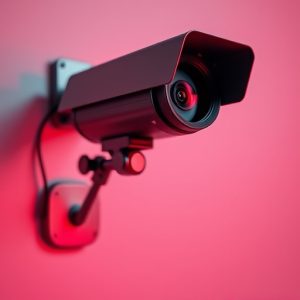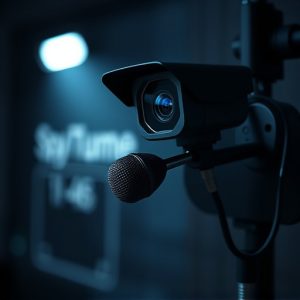Secure Communications Under Siege: The Rise and Regulation of Spy Cameras and Microphones
Advanced spy cameras and microphones have undergone a transformation, evolving from fictional gadget…….
Advanced spy cameras and microphones have undergone a transformation, evolving from fictional gadgets to highly sophisticated, miniaturized devices that can be seamlessly integrated into everyday objects like smoke detectors or clocks. These tools offer high-quality audio and visual intelligence while remaining undetected, serving a wide range of purposes from law enforcement surveillance to personal security and commercial quality control. Their small size and stealth capabilities have significantly expanded their utility in covert operations. However, the widespread use of these devices raises important privacy concerns and necessitates strict adherence to privacy rights and data protection laws. The ethical deployment of spy cameras and microphones requires clear guidelines and consent to prevent misuse and maintain trust, highlighting the need for ongoing discussions and policies that balance security with individual privacy.
In an age where technology blurs the lines between visibility and invisibility, the role of spy cameras and microphones has become a subject of both intrigue and concern. This article delves into the covert mechanics that enable these devices to operate undetected, exploring their capabilities and varied applications. It also charts the evolution from the fictional gadgets of James Bond lore to the miniature marvels of today. Furthermore, it prompts a critical examination of the legal and ethical considerations surrounding their use in everyday scenarios, ensuring a comprehensive understanding of the implications these technologies carry.
Unveiling the Stealthy Mechanics of Spy Camera and Microphones: A Deep Dive into their Capabilities and Applications
Spy cameras and microphones represent a sophisticated arsenal in the field of covert surveillance, meticulously designed to remain undetected while capturing high-quality audio and visual data. These devices are engineered with stealth as their foremost principle, often resembling innocuous everyday objects. The miniaturization of electronic components has allowed for the creation of tiny cameras that can be concealed within items like smoke detectors, clocks, or even buttons. These devices can record hours of footage, storing the data either internally or transmitting it in real-time to a secure location.
In parallel with their discreet design, spy microphones are equally adept at intercepting conversations from a distance, often utilizing directional or omnidirectional pickups that can capture audio within a specified range. They are capable of transmitting sound in various formats, ensuring the integrity and clarity of the recordings. The applications for such devices span across multiple domains, including law enforcement for intelligence gathering, personal security, and even commercial uses like quality control or discreet monitoring of employee interactions. Their effectiveness lies not only in their ability to provide valuable insights but also in their capacity to operate undetected, ensuring the privacy and security of sensitive information.
The Evolution of Hidden Eavesdropping Tools: From James Bond Gadgets to Modern Miniatures
The practice of covert surveillance has seen significant advancements over the years, transitioning from the fictionalized gadgets of James Bond lore to the sophisticated miniatures employed in modern espionage. Early eavesdropping devices were bulky and required conspicuous setups, making them vulnerable to detection. Over time, technological innovation has led to the development of smaller, more efficient spy cameras and microphones that are virtually undetectable. These compact devices now blend seamlessly into everyday objects such as clocks, smoke detectors, and even buttons, enabling agents to gather intelligence without raising suspicion. The miniaturization of these components not only enhances stealth but also expands the possibilities for discreet monitoring, allowing for long-term surveillance with a level of covertness that was once unimaginable. The integration of advanced audio processing capabilities into these tiny devices has also improved their effectiveness, ensuring clear and reliable audio capture in various environments. This evolution reflects the broader trend in consumer electronics towards smaller, more powerful, and more integrated technology, which has, in turn, propelled the development of sophisticated spy cameras and microphones that are indispensable tools for modern intelligence operations.
Understanding the Legal and Ethical Implications of Using Spy Cameras and Microphones in Everyday Scenarios
The advent of miniaturized technology has rendered spy cameras and microphones ubiquitous in today’s world, with applications ranging from security to covert surveillance. As these devices become more accessible, it is imperative to scrutinize their deployment within the legal and ethical frameworks that govern privacy and data protection. Legally, the use of hidden cameras and microphones is regulated by various laws that differ across jurisdictions. These laws typically require consent from all parties being recorded, with some exceptions for situations such as crime prevention or national security. However, navigating these legal complexities can be challenging, as the line between legitimate surveillance and unauthorized spying blurs with advancements in technology.
Ethically, the use of spy cameras and microphones raises concerns about consent, the right to privacy, and the potential for abuse. Ethical considerations demand that such devices are used responsibly and transparently, with clear guidelines on their permissible use cases. Employers, for instance, must weigh the benefits of installing hidden cameras for security purposes against the rights of employees to maintain their privacy. Similarly, individuals using these devices must be cognizant of the trust and respect they owe to those around them. The implications of unauthorized recording are profound, as it can lead to breaches of trust, invasion of privacy, and even criminal charges. As society continues to grapple with the implications of spy technology, ongoing dialogue and clear policy-making are essential to balance the needs for security and surveillance with the fundamental right to privacy.


